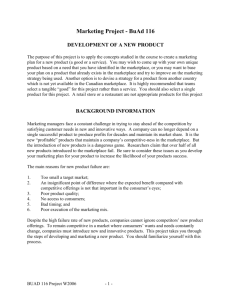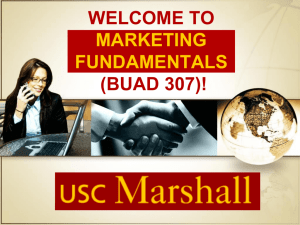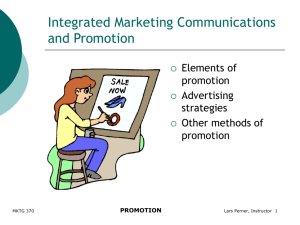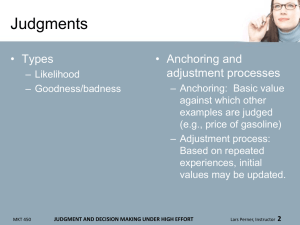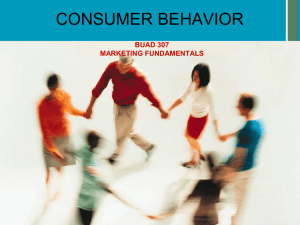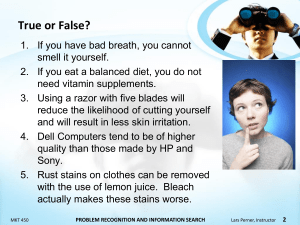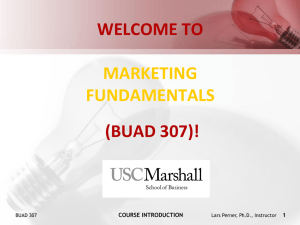Product
advertisement
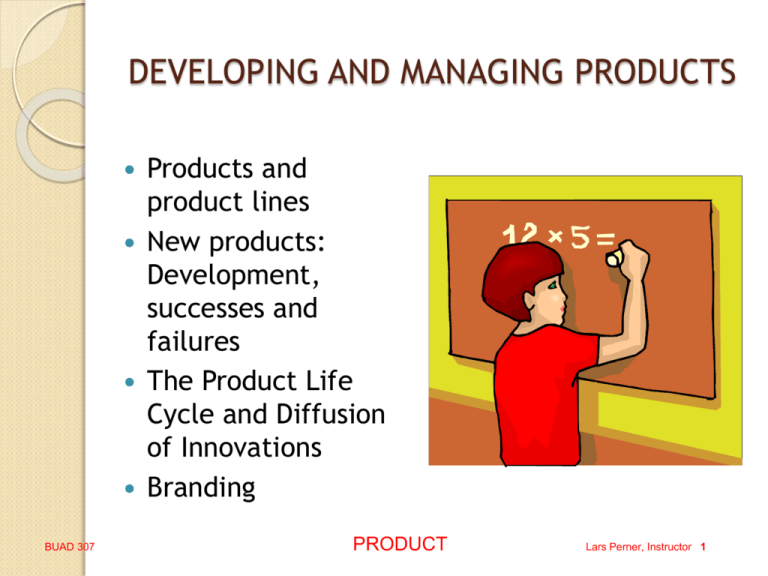
DEVELOPING AND MANAGING PRODUCTS BUAD 307 Products and product lines New products: Development, successes and failures The Product Life Cycle and Diffusion of Innovations Branding PRODUCT Lars Perner, Instructor 1 Learning Objective #1 The choices firms need to make on new product introductions IMAGE/ POSITIONING DIFFERENTIATION IDEAS AND EVALUATIONS RISK CHOICES PRODUCT DECISIONS TEST MARKETING DISTRIBUTION BUAD 307 PRODUCT LINES PRODUCT BRANDING BRAND EXTENSIONS COMPETITIVE RESPONSE Lars Perner, Instructor 2 Learning Objective #2 Steering the product through the Product Life Cycle FEATURES DIFFERENTIATION BRAND STRUCTURE DIFFUSION AWARENESS IMAGE/ POSITIONING PRODUCT -CATEGORY -BRAND PRICE BUAD 307 COMPETITION PRODUCT SUBSTITUTES PARTNERSHIPS Lars Perner, Instructor 3 The Product Life Cycle (PLC) Products will generally be invented and start with low use. With decreased costs and improved technology, more people tend to adopt. The product life cycle can reach: ◦ Plateau ◦ Decline ◦ Revitalization Peak (Maturity) Plateau Revitalization BUAD 307 PRODUCT Lars Perner, Instructor 4 Some PLC Stage Examples BUAD 307 Color TVs: Decline Black and white TVs: Decline HDTVs: Growth VCRs: Decline DVD players: Decline. Jeans: Maturity Fast food: Growth/maturity Traditional photography: Decline PRODUCT Digital photography: Growth/maturity Fax machines: Decline Travel agencies: Decline Cranberry juice: Revitalization Lars Perner, Instructor 5 The Product Life Cycle (PLC) involves ________ over time BUAD 307 Demand for the product Awareness of the product Competition in supplying the product ◦ Price ◦ Features ◦ Differentiation Profitability Alternatives available to the product PRODUCT Investment opportunities (Boston Consulting Group model) Appropriate strategies Lars Perner, Instructor 6 Types of Innovations Continuous--same product, just small improvements over time-e.g., typical automobile/stereo system model changes Dynamically continuous--product form changed, but function and usage are roughly similar--e.g., jet aircraft, ball point pen, word processor Discontinuous--entirely new product; usage approach changes (e.g., fax) BUAD 307 PRODUCT Lars Perner, Instructor 7 The Chicken-and-Egg Problem Some programs require two components, each of which must be present before the other can be attracted ◦ E.g., an online auction site needs both buyers and sellers. Buyers are less motivated to come when there are few sellers, but buyers are needed to attract sellers. BUAD 307 A “jump start” may be needed— e.g., period of free service in return for early signup PRODUCT Lars Perner, Instructor 8 Examples of “Chicken-and-Egg” Vulnerable Ventures BUAD 307 Personals sites Auction sites Text messaging systems “Wiki” projects Carpool systems Electric cars Computers and software Fashion PRODUCT Lars Perner, Instructor 9 Some Diffusion Examples ATMs (*) ◦ Easy observability ◦ Significant relative advantage Credit cards (*) ◦ Network economies Faded, torn jeans ◦ Fads ◦ Innovations do not have to be high tech Rap music ◦ Low barriers to entry ◦ “Chicken-and-egg” problem ◦ “Jump-starting the cycle” Fax machines (*) ◦ Spread to a new consumer group Hybrid corn (*) ◦ Trialability ◦ Imitation *You should be able to discuss these case histories on the final BUAD 307 PRODUCT Lars Perner, Instructor 10 Diffusion Themes Observability: Products that can be seen being used to others tend to spread faster “Chicken-and-egg” problem: A certain infrastructure is needed to make adoption attractive, but motivation to provide the infrastructure depends on market size—e.g., ◦ ◦ ◦ ◦ BUAD 307 Coupons and clearinghouses Hydrogen/electric cars HDTV Entertainment media Trialability: People tend to prefer “trying out” a potentially costly innovation rather than having to commit before trial Network economies: Some innovations become more valuable when more others have that innovation—e.g., ◦ ◦ ◦ ◦ ◦ PRODUCT Text messaging E-mail Online personals sites Other online communities Auction sites Lars Perner, Instructor 11 To Adopt or Not to Adopt: How Will Consumers Answer the Question? Some causes of resistance to adoption ◦ Perceived risk--financial and social ◦ Self image ◦ Effort to implement and/or learn to use the product ◦ Incompatibility ◦ Inertia BUAD 307 PRODUCT Lars Perner, Instructor 12 Influences on the Speed of Diffusion Risk to expected benefit ratio (relative advantage) Product pricing Trialability Switching difficulties and learning requirements/ ease of use BUAD 307 PRODUCT Lars Perner, Instructor 13 Break-Even Sales Volume Points Two types of costs ◦ Fixed: Generally independent of quantity produced within a certain range (e.g., R&D, equipment needed, setup, overhead) ◦ Variable (marginal): Costs of making one additional unit (e.g., labor, materials) BUAD 307 At what quantity sold will the firm break even—i.e., cover costs without making a profit? QUANTITY, REVENUE, COSTS, AND NET PROFIT $400,000.00 $300,000.00 $200,000.00 Total Revenue $100,000.00 Total Costs Net Profit $0.00 -$100,000.00 0 10000 20000 30000 -$200,000.00 PRODUCT Lars Perner, Instructor 14 QUANTITY, REVENUE, COSTS, AND NET PROFIT $400,000.00 $350,000.00 $300,000.00 Total Revenue = Total Cost $250,000.00 Zero net profit $200,000.00 Total Revenue $150,000.00 Total Costs Net Profit $100,000.00 $50,000.00 $0.00 0 -$50,000.00 -$100,000.00 -$150,000.00 5000 10000 15000 20000 25000 Break-Even Quantities BUAD 307 PRODUCT Lars Perner, Instructor 16 Quantity Total Revenue 1 100 500 1000 2000 3000 4000 5000 6000 7000 8000 9000 10000 11000 12000 13000 14000 15000 16000 17000 18000 19000 20000 21000 22000 BUAD 307 Total Costs $15.00 $1,500.00 $7,500.00 $15,000.00 $30,000.00 $45,000.00 $60,000.00 $75,000.00 $90,000.00 $105,000.00 $120,000.00 $135,000.00 $150,000.00 $165,000.00 $180,000.00 $195,000.00 $210,000.00 $225,000.00 $240,000.00 $255,000.00 $270,000.00 $285,000.00 $300,000.00 $315,000.00 $330,000.00 PRODUCT Net Profit $100,008.00 $100,800.00 $104,000.00 $108,000.00 $116,000.00 $124,000.00 $132,000.00 $140,000.00 $148,000.00 $156,000.00 $164,000.00 $172,000.00 $180,000.00 $188,000.00 $196,000.00 $204,000.00 $212,000.00 $220,000.00 $228,000.00 $236,000.00 $244,000.00 $252,000.00 $260,000.00 $268,000.00 $276,000.00 -$99,993.00 -$99,300.00 -$96,500.00 -$93,000.00 -$86,000.00 -$79,000.00 -$72,000.00 -$65,000.00 -$58,000.00 -$51,000.00 -$44,000.00 -$37,000.00 -$30,000.00 -$23,000.00 -$16,000.00 -$9,000.00 -$2,000.00 $5,000.00 $12,000.00 $19,000.00 $26,000.00 $33,000.00 $40,000.00 $47,000.00 $54,000.00 Lars Perner, Instructor 17 Assumptions in Simple Break Even Analysis No additional manufacturing capacity will be needed to make any of the quantities considered All customers pay the same price No interest on sales made after the initial period No periodic fixed effects Marginal costs of resources remain constant ◦ No quantity discounts ◦ No increase in costs due to limited market supply BUAD 307 PRODUCT Lars Perner, Instructor 18 Alternative Approach: New Products an Investments Calculation of net present value (NPV)--discounted cash flows over time for ◦ R&D expenses ◦ Setting up manufacturing capacity ◦ Period fixed expenses (e.g., cost of buildings and equipment depreciation) ◦ Total revenue BUAD 307 Discount rate should reflect the risk associated with the specific product considered More complex models assign probabilities to various outcomes (e.g., competitor entry, reaching certain sales levels, changes in resource costs) This approach is covered in finance and managerial accounting courses PRODUCT Lars Perner, Instructor 19 Branding Brands ◦ Product or product line specific brands E.g., Tide, DeWalt, Hayes modem International issues ◦ “Umbrella Brands” 3M ◦ National vs. regional ◦ National vs. international ◦ Store brands Trade marks and “genericide” BUAD 307 PRODUCT Branding has been traced to whiskey casks that were identified for quality. Lars Perner, Instructor 20 Brand Value and Image Brand equity: Value added to product based on brand name ◦ Choice likelihood ◦ Ability to charge higher price ◦ Use of product as loss leader Benefit in market share, temporary revenue (Coca Cola) Possible damage to long term brand image (Louis Vuitton suitcases in Japan) BUAD 307 Brand “personality:” Associations with product PRODUCT Lars Perner, Instructor 21 Co-branding ◦ Ingredients To take advantage of assets of both firms Types ◦ Distributional Cooperative: Dryers’ ice cream with Mars M&Ms Independent: Local computer maker advertises Maxtor hard drive components ◦ Intrusive: “Intel Inside” ◦ Partial: McD’s serves Coca Cola ◦ Sponsorship: Good Housekeeping seal of approval Egalitarian: Carl’s Jr. and Green Taco Hierarchical: Visa as official credit card of the Olympics ◦ Line filling—e.g., airline code sharing BUAD 307 PRODUCT Lars Perner, Instructor 22 Brand Extensions Use of an existing brand name to a new-to-the-brand product category May lower cost of launching new product line and increase speed of market penetration, but… Considerations ◦ Congruence: Are products consistent in image to be represented by the same brand name? Coke and Diet Coke Miller vs. Miller Light Beer BUAD 307 PRODUCT ◦ Perception of ability to make product well ◦ Extension should not be exploitative— making a “trivial” product by high image brand (e.g., Heineken Popcorn) ◦ Order of entry: First manufacturer of new to market product should not extend an existing brand—this causes confusion Lars Perner, Instructor 23

